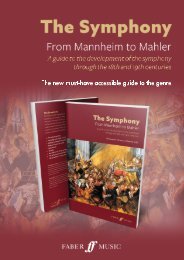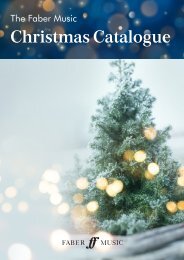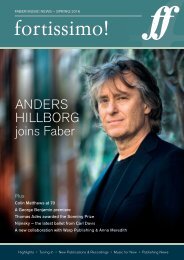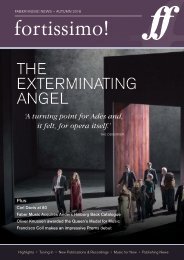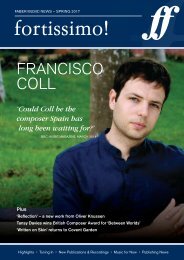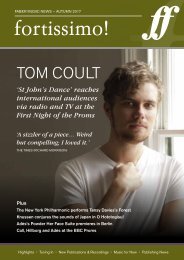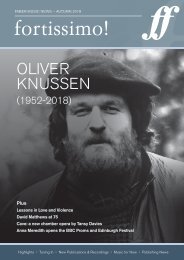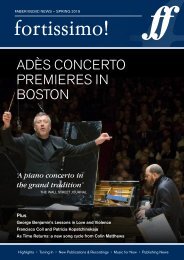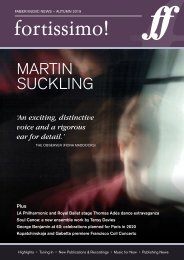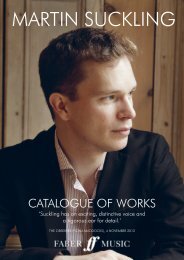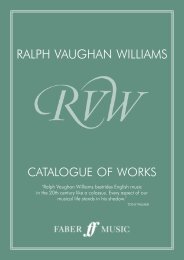A world full of rhythm by Mary Cohen
Author Mary Cohen is one of Britain’s leading string teachers. In this article, she delves into ideas about how to teach rhythm effectively for strings.
Author Mary Cohen is one of Britain’s leading string teachers. In this article, she delves into ideas about how to teach rhythm effectively for strings.
You also want an ePaper? Increase the reach of your titles
YUMPU automatically turns print PDFs into web optimized ePapers that Google loves.
a <strong>world</strong> <strong>full</strong><br />
<strong>of</strong> <strong>rhythm</strong><br />
<strong>by</strong> <strong>Mary</strong> <strong>Cohen</strong><br />
Rhythmic! Whacky! Engaging! Can classical music really be like this for beginner string<br />
players? Of course it can! Alongside the fun and games, classical music itself should be an<br />
essential part <strong>of</strong> the mix at the earliest stages, especially in a culture where it is becoming<br />
sidelined. We live in a <strong>world</strong> <strong>full</strong> <strong>of</strong> vibrant <strong>rhythm</strong> – it leaks out <strong>of</strong> earphones everywhere. So<br />
first lessons should be <strong>rhythm</strong>ic – and you can easily introduce open strings using <strong>rhythm</strong>s<br />
that fit with well-known classical tunes. Fragments <strong>of</strong> pop and jazz <strong>rhythm</strong>s can be found in<br />
Bach, Telemann and Vivaldi!<br />
How to teach <strong>rhythm</strong> effectively? Simple – just do lots <strong>of</strong> it. In the earliest stages it’s easy<br />
to use words to reinforce <strong>rhythm</strong>s: a good start to the lesson is inventing ‘News <strong>of</strong> the Day’<br />
<strong>rhythm</strong>s, using a phrase like ‘I had pizza for lunch today’. Straight or syncopated, begin with<br />
open strings; as skills progress try harmonics or col legno, sul ponticello or even the squeaky<br />
bits <strong>of</strong> string behind the bridge. As finger patterns are established, move on to half scales,<br />
<strong>full</strong> scales and arpeggios. (A fun way <strong>of</strong> sneaking some musical general knowledge into the<br />
lessons is to imagine what Mozart, Beethoven or other classical composers might have had<br />
for their lunch.) Years <strong>of</strong> observation has convinced me that pupils need to learn to sightsay<br />
the <strong>rhythm</strong> <strong>of</strong> new pieces. It doesn’t matter which <strong>rhythm</strong>-name scheme you use as<br />
long as it is consistent. (All the material in the Superseries is designed to be introduced in<br />
this way.) Pupils who learn <strong>rhythm</strong> as a language, and can use <strong>rhythm</strong> names on autopilot,<br />
are brilliant at duets and chamber music from a very early stage. It’s fun to get intermediate<br />
pupils to play some Vivaldi to a beginner class and then for everyone to sit down<br />
together and ‘<strong>rhythm</strong> sing’ bits <strong>of</strong> it. You only need about six different<br />
<strong>rhythm</strong> names to do a big chunk <strong>of</strong> the A minor double<br />
concerto – a great motivator for pupils. Another<br />
winner is singing <strong>rhythm</strong> names to part <strong>of</strong><br />
Mozart’s Symphony No. 40 – a real<br />
tongue twister if done up<br />
to speed.
Much <strong>of</strong> my time is spent doing chamber music and accompanying pupils from the piano,<br />
so they are contributing to a ‘greater picture’. But I also give them material that is complete<br />
with just one line. This completeness is an important ingredient <strong>of</strong> the Bags <strong>of</strong>… series<br />
(eight books <strong>of</strong> fun solo pieces for violin, viola and cello that range from beginner to grade<br />
4). As well as strong tunes, the pieces are <strong>full</strong> <strong>of</strong> patterns designed to encourage <strong>rhythm</strong>ic<br />
playing and confident reading skills from the beginning – and they also work really well<br />
with late starters and timid adult re-starters.<br />
we live in a <strong>world</strong> <strong>full</strong> <strong>of</strong> vibrant <strong>rhythm</strong><br />
Rhythmic confidence produces fluent musical playing that gives pleasure to performer and<br />
listener alike. And the wonderful bonus is that when pupils focus on getting the <strong>rhythm</strong><br />
right they <strong>of</strong>ten play better in tune!<br />
<strong>Mary</strong> <strong>Cohen</strong><br />
studied violin, piano, chamber music<br />
and composition at the Royal College <strong>of</strong> Music, then spent several<br />
years in the City <strong>of</strong> Birmingham Symphony Orchestra before<br />
setting up a <strong>full</strong>-time teaching practice. <strong>Mary</strong> has an international<br />
reputation as an educational composer, with over 60 titles in<br />
print. Many <strong>of</strong> her publications centre around the technical<br />
requirements specific to particular stages <strong>of</strong> string playing, but<br />
always in the context <strong>of</strong> a ‘real’ musical experience.<br />
<strong>Mary</strong> enjoys writing news blogs for the Faber Music website, and<br />
also posts photos and tips on her <strong>Mary</strong>’s Music Cupboard Facebook<br />
page.




